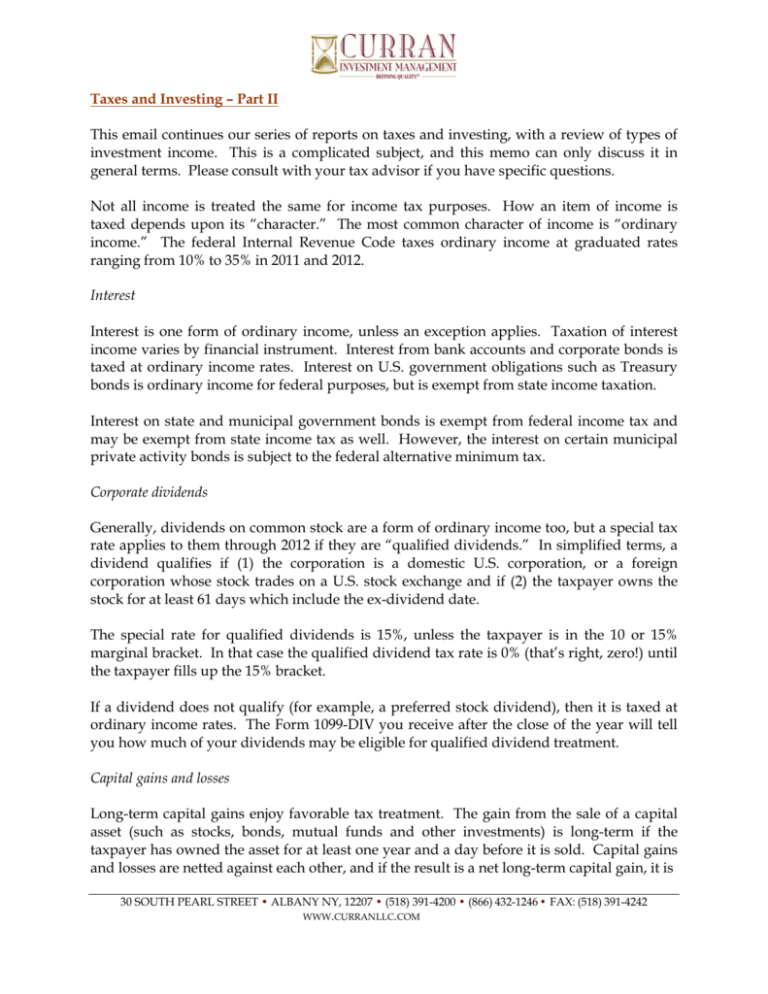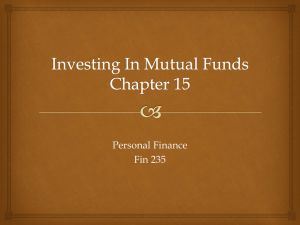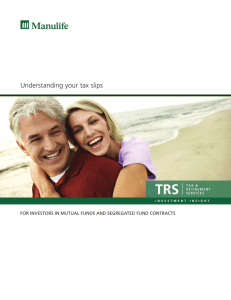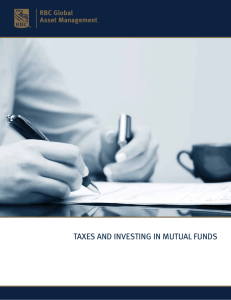Taxes and Investing Part II - Curran Investment Management
advertisement

Taxes and Investing – Part II This email continues our series of reports on taxes and investing, with a review of types of investment income. This is a complicated subject, and this memo can only discuss it in general terms. Please consult with your tax advisor if you have specific questions. Not all income is treated the same for income tax purposes. How an item of income is taxed depends upon its “character.” The most common character of income is “ordinary income.” The federal Internal Revenue Code taxes ordinary income at graduated rates ranging from 10% to 35% in 2011 and 2012. Interest Interest is one form of ordinary income, unless an exception applies. Taxation of interest income varies by financial instrument. Interest from bank accounts and corporate bonds is taxed at ordinary income rates. Interest on U.S. government obligations such as Treasury bonds is ordinary income for federal purposes, but is exempt from state income taxation. Interest on state and municipal government bonds is exempt from federal income tax and may be exempt from state income tax as well. However, the interest on certain municipal private activity bonds is subject to the federal alternative minimum tax. Corporate dividends Generally, dividends on common stock are a form of ordinary income too, but a special tax rate applies to them through 2012 if they are “qualified dividends.” In simplified terms, a dividend qualifies if (1) the corporation is a domestic U.S. corporation, or a foreign corporation whose stock trades on a U.S. stock exchange and if (2) the taxpayer owns the stock for at least 61 days which include the ex-dividend date. The special rate for qualified dividends is 15%, unless the taxpayer is in the 10 or 15% marginal bracket. In that case the qualified dividend tax rate is 0% (that’s right, zero!) until the taxpayer fills up the 15% bracket. If a dividend does not qualify (for example, a preferred stock dividend), then it is taxed at ordinary income rates. The Form 1099-DIV you receive after the close of the year will tell you how much of your dividends may be eligible for qualified dividend treatment. Capital gains and losses Long-term capital gains enjoy favorable tax treatment. The gain from the sale of a capital asset (such as stocks, bonds, mutual funds and other investments) is long-term if the taxpayer has owned the asset for at least one year and a day before it is sold. Capital gains and losses are netted against each other, and if the result is a net long-term capital gain, it is 30 SOUTH PEARL STREET • ALBANY NY, 12207 • (518) 391-4200 • (866) 432-1246 FAX: (518) 391-4242 WWW.CURRANLLC.COM taxed for 2011 and 2012 at the same special rate that applies to qualified dividends (see above). If the result is a net short-term capital gain, it is taxed at ordinary income rates. There is an exception for long-term capital gains from the sale of certain kinds of capital assets. For example, long-term gains on collectibles are taxed up to a top rate of 28%. If capital losses exceed capital gains, the net capital loss is applied against the taxpayer’s other income, up to $3,000 per year. Amounts in excess of $3,000 carry forward to future years. Mutual fund distributions A mutual fund is a “regulated investment company” for income tax purposes. To keep its tax-favored status, a mutual fund is required by law to distribute almost all of its profits to shareholders each year. A mutual fund distribution passes on to shareholders the character of the income received by the mutual fund. So, for example, as the end of the year approaches, a mutual fund may distribute amounts representing dividends it received (which may or may not be qualified dividends) from stocks that it owns, as well as shortterm and long-term capital gains from securities that it sold during the year. (A mutual fund does not “distribute” a net capital loss. Rather, the loss carries over in the mutual fund to future years.) If the mutual fund is a bond fund, it distributes interest income to shareholders, usually throughout the year. The mutual fund will report these distributions to its shareholders on Form 1099-DIV after the close of the year. A mutual fund shareholder reports these distributions on his or her tax return according to the character of the income distributed. If you are buying an equity mutual fund in a taxable account (i.e., other than an IRA or other tax-deferred account) near the end of the year and the fund has significant income for the year, you should make sure that the purchase is after the distribution date, otherwise you will be hit with a taxable distribution from the fund’s profits for the entire year. Apart from distributions, a mutual fund shareholder may incur a capital gain or loss when he/she sells the shares. Exchange-Traded Funds (ETFs) If you own an exchange-traded fund in a taxable account, the income tax treatment depends upon how the ETF is structured. Many ETFs are treated as regulated investment companies (i.e., mutual funds) for income tax purposes, so that their profits are distributed to shareholders and reported on Form 1099-DIV (see discussion above). However, some ETFs are organized as limited partnerships (for example, the PowerShares DB Commodity Index Tracking Fund (“DBC”)) and will generate a Schedule K-1 to investors, whether or not any distributions are made. (A Schedule K-1 is a tax form issued after the end of the year that reports each owner’s proportionate share of the partnership’s income and losses for the year.) A few ETFs are structured as “grantor trusts” for tax purposes (for example, the SPDR Gold Trust (“GLD”)). You should be able to find an ETF’s tax status in the fund Prospectus or the accompanying Statement of Additional Information. Tax-Deferred and Tax-Free Accounts The rules discussed up to this point pertain to investments held in taxable accounts. In general, there are no immediate tax consequences to investments held in tax-deferred accounts, such as IRAs, until the owner takes a distribution. Unless the owner has made after-tax contributions to the IRA, a distribution is 100% taxable as ordinary income. In addition, if the owner is younger than 59½ years of age, the payment may be subject to a 10% early distribution penalty. The best tax treatment of all is reserved for investments in tax-free accounts, like Roth IRAs. Once certain time requirements are met and the owner has reached age 59½, distributions from a Roth IRA are entirely income tax-free. Section 529 plan withdrawals are also tax-free when they are used to pay for qualified higher education expenses. Conclusion As you can see from the foregoing discussion, the taxation of investment income is a complicated subject. Always consult with your tax advisor about your specific situation. Please contact your Relationship Manager if you have any questions about the subject of this email, or feel free to contact CIM’s Wealth Strategist, Art Dicker, at (518) 391-4280. Circular 230 disclaimer: If any advice concerning one or more U.S. Federal tax issues is contained in this communication (including any attachments), such advice is not intended or written to be used, and cannot be used, for the purpose of avoiding penalties under the Internal Revenue Code or promoting, marketing or recommending to any party any transaction or matter addressed herein.







